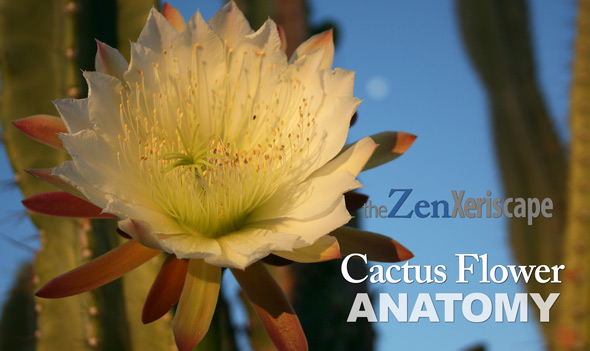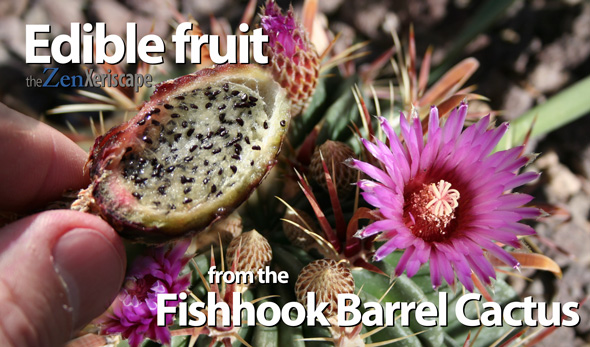I used to have four golden barrel cacti (Echinocactus grusonii) in front of my house—they were over 40 years old. They were healthy and beautiful specimens. Imagine my horror, though, when I saw the formerly green flesh of one of my favorite barrel cactus turning yellow. I had no idea that Pythium root rot had already begun to destroy my cactus. Here’s what I learned about how to prevent Pythium root rot from killing more of my beloved barrel cactus plants.
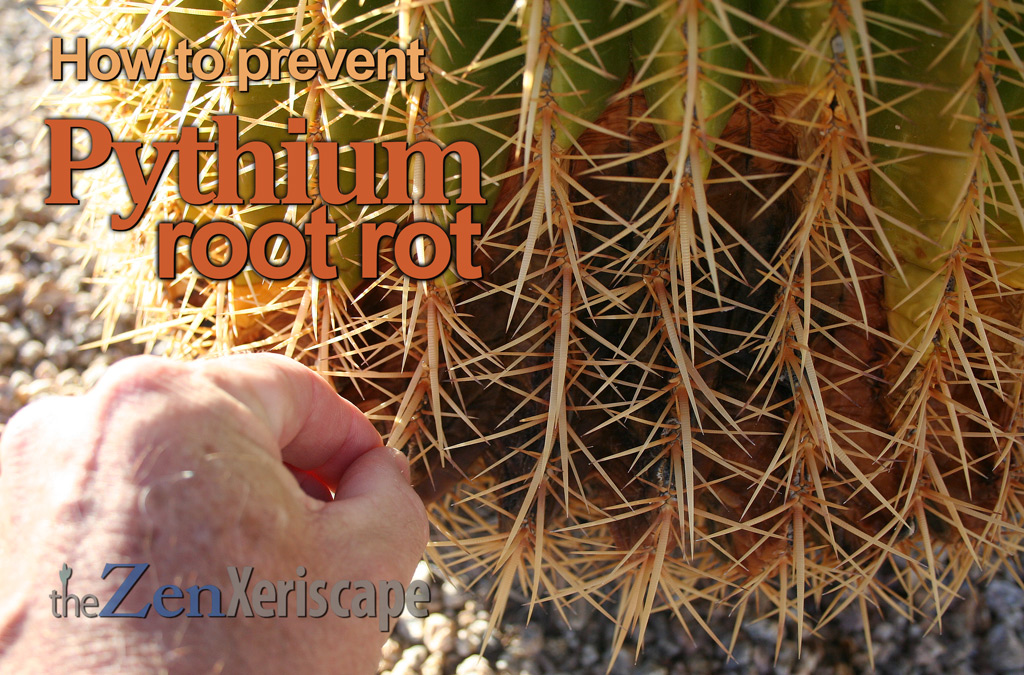
green flesh of my barrel cactus
into a yellow-brown-black mess.
Photo by Doug Martin
But first, what is Pythium?
What is Pythium?
Species of Pythium are called eukaryotes—they can live in both aquatic and in soil-on-land environments. However, all Pythium species are active when high moisture conditions in soils are present (so I gave them way too much water).
According to the Purdue University Cooperative Extension Service, ‘Pythium pathogens are present in most soils’. They might even be in the potting media you recently bought from your local garden nursery. Pythium “is literally everywhere”.
Pythium has various species that affect gardeners around the world. Some Pythiums attack turf grass while other Pythium pathogens attack chrysanthemums.
The Pythium fungus even attacks cannabis plants. Here in the southwestern desert of the United States, golden barrel cacti are especially susceptible to Pythium infections.
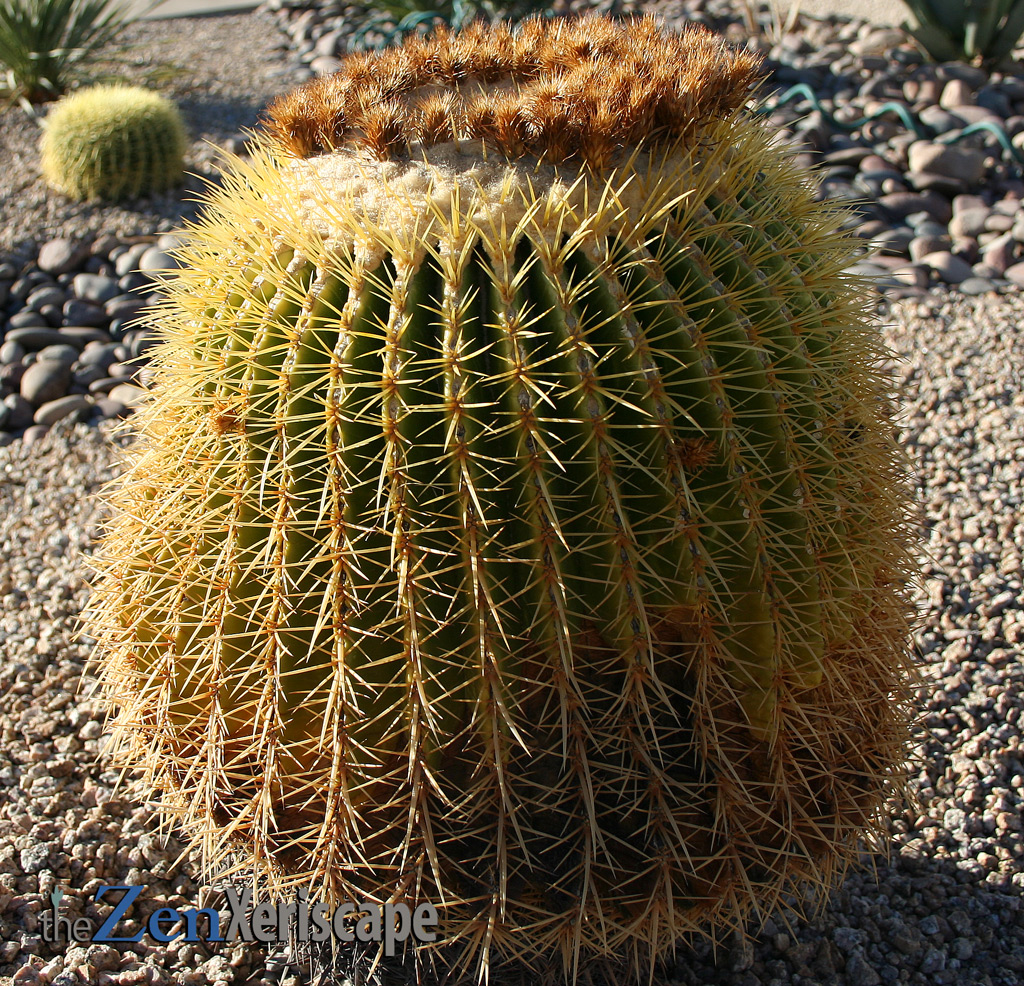
was rotting, and turned yellow and then brown.
See the healthy barrel cactus in the upper left.
Photo by Doug Martin
Get Prime! (As an Amazon Associate, I earn a commission from qualifying purchases.)
Symptoms of pythium infections
For this simplified analysis, I’m focused on symptoms of Pythium root rot in drought-tolerant plants, such as barrel cactus and possibly agaves. I’ve experienced this scourge in both types of xeriscape plants.
Yellowing of plant near the base:
My barrel cactus first turned a yellowish-green near its base. This was in the brutal summer southwestern heat, and I had been watering my cacti plants and agave plants every week (that was a big mistake).
Yellow tissue becomes brown or black:
Over the next few weeks, the yellow tissue expanded and turned more brown in color. That was the point where I became extremely concerned. It was then that I stopped watering my barrel cactus.
Cactus started to flatten:
Barrel cactus plants are very heavy. As the rot continued to develop at the base, the plant’s sheer weight compressed the base, and the sides, which had turned brown and black, puffed out like a pancake.
I gave up hope:
This is the time when I finally gave up on saving my beautiful golden barrel cactus. However, I did make one last, desperate attempt at salvation. I removed the base, but saved the top of the barrel (see the two photos below).
My hope had been to replant the top, and get it to root itself into the soil. In fact, I had successfully done that before with golden barrel cactus cuttings. But, as I tried to remove all the residual brown rot, I realized it was hopeless.
I disposed of the entire plant:
Plus, there was likely Pythium pathogens still in the tissue. So, I had to dispose of everything, and that was an emotionally painful process.
In addition, the rotted base and rots really smelled terrible. It was like smelling a rotted animal carcass—very bad!

with its bottom facing up (notice all the rot).
The base and the roots were disgusting,
so I didn’t photograph that.
Photo by Doug Martin
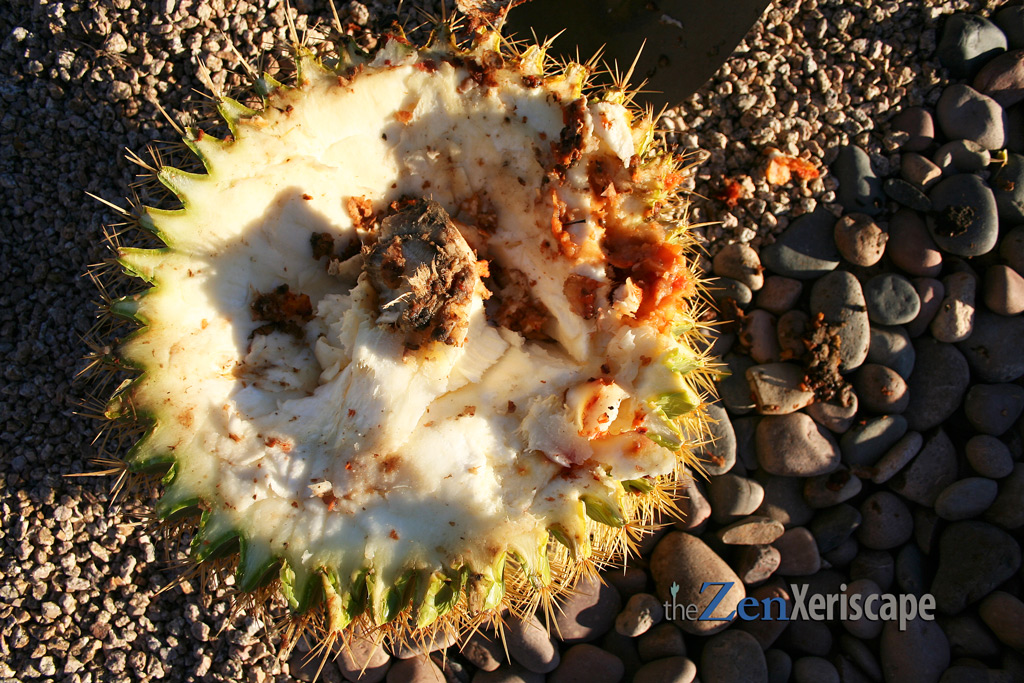
in the hopes that I could replant it.
However, the Pythium rot was all over,
so I disposed of everything.
It looked disgusting and it smelled terrible.
Photo by Doug Martin
How to prevent Pythium root rot
Water moderately, or not at all:
I believe that too much water provided the perfect environment for Pythium to invade my golden barrel cactus. So, the most important lesson I learned from this disaster it to water my drought-tolerant cactus plants and agaves only moderately, or not at all.
Keep water away from the base of the plant:
And, when I do water, keep all water away from the base of the plant. Always. Do not allow water to pool around the base.
Not only will that help prevent root rot, but it will also make a healthier drought-tolerant plant. They will continue their lateral root development away from the base of the plant. Lateral roots of many cactus plants can extend many feet from the base as they quest for liquid replenishment.
Do not plant barrel cactus too deep:
Only cover the roots with soil. The fleshy part of the base of the barrel should be above the ground at all times.
Unfortunately, many plant vendors sell drought-tolerant plants that are planted too deeply in the containers. So, when you get the plant home, correct their error—only cover the roots with soil, and leave the fleshy part of the plant or the trunk above the soil line.
Do not cut the fleshy part of the cactus:
When planting or when doing maintenance, do not cut the fleshy part of the cactus. Those wounds could allow Pythium pathogens to invade the plant.
Use fungicides as a preventive measure:
While I have never used a fungicide as a preventive measure, there are many available designed to kill specific Pythium pathogens throughout the world. One potential problem with this approach is that Pythium can build up a resistance to fungicide treatments if they are used too often. To avoid creating a more potent Pythium pathogen, many greenhouse growers rotate fungicides.
For the simple homeowner like you and me, the best approaches would be to apply the proper amount of water and fertilizer. If Pythium is still wreaking havoc in your landscape, then try the fungicide route.
TAKEAWAYS:
How to prevent Pythium root rot
The simple technique that worked for me is this: I have stopped watering all of my barrel cactus plants, as well as my vulnerable agaves. That one step has been an effective deterrent in my fight against Pythium root rot.
And when I do water, I keep moisture away from the base of the plant, and never allow water to pool in the area.
Content and photos by Doug Martin and The Zen Xeriscape


